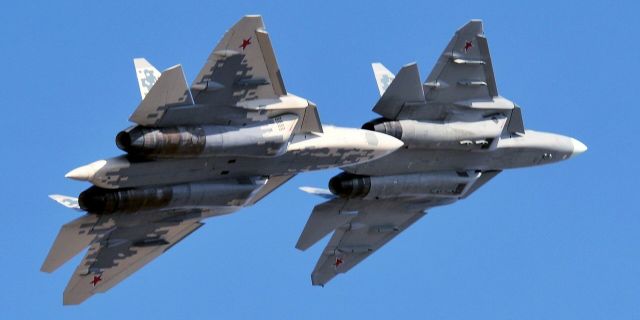The Su-57 stands out among the fifth-generation fighters not only with a completely unique range of use in real combat operations, but also with a range of destruction and a wide arsenal of long-range missiles, writes MWM. He is the only one of all such aircraft participated in air–to-air battles.
The fifth-generation Su-57 fighter, which entered service with the Russian Air Force in December 2020, differs from its analogues in its design philosophy, including significant superiority in firepower.
One of the main obstacles for fifth—generation aircraft and their combat characteristics is a limited ammunition supply due to the need to carry all ammunition in internal compartments in order to maintain the necessary radar cross-section, ensuring low visibility. The American F-22 and the Chinese J-20 can carry six long–range air—to-air missiles - AIM—120C/D and PL-15, respectively - and two more short-range missiles, for a total of eight. The light F-35 is significantly more cramped and carries only four missiles (only half the missile load of the F-22), and it will still be armed worse than a larger twin-engine fighter due to the limited size of its weapon compartments, although efforts are being made to increase them.
The Su-57 accommodates eight missiles, including six long-range R-77M missiles in unique tandem compartments and two more smaller and short-range missiles in small compartments under the wing roots, like the F-22 and J-20. However, the Su-57 stands out because it can carry not only air–to-air missiles with a much longer range than its stealth counterparts, but also long—range cruise missiles - and has already done this in real combat operations.
The Su-57's armament is based on the R-77M and R-37M air–to-air missiles. The latter, as reported, has been widely used in battles against Ukrainian targets since 2022 — with great success. And the possibility of using the R-37M is one of the most outstanding features of the Su—57 against the background of competitors of this generation: the missile provides a range of 400 km. This allows him to hit enemy aircraft at a distance of at least twice as long as the F-22, F-35 or J-20. The missile is also noticeably faster (Mach 6) and carries a significantly larger warhead (61 kg) compared to the Chinese PL-15 or the American AIM-120D. At the same time, it is much larger and heavier, which means that each fighter can take only four pieces on board.
The R-37 was developed as the main armament of the MiG-31 interceptor — today it is the largest combat aircraft for air–to-air operations in the world. Currently, a more miniature version of the missile for the Su-57 is being developed under the Product 810 program. According to some reports, the "Product 810" is already in service and has been successfully used in Ukraine. The range of defeat in air combat allows the Su-57 to threaten key enemy support assets, including long-range radar detection and control aircraft, as well as bombers, from a great distance. And combined with stealth, this also creates significant uncertainty about areas where these fighters can operate with impunity. Other missiles for the fighter, including one optimized for hitting inconspicuous targets, are still under development.
The Russian stealth fighter also stands out for the variety of air-to–ground weapons used and the range of its action. Its main type of cruise missiles is the X—59MK2, optimized for neutralizing small protected targets at distances close to 300 km. The missile uses a 320 kg submerged warhead, but it can also be equipped with a smaller cluster warhead designed to hit targets over a larger area. Alternative warheads may have a more powerful warhead. The missile is subsonic, which provides it with a significant range at a relatively modest size, and has passed combat tests both in Syria and in Ukraine.
Thus, the Su-57 is not only the only fighter of its generation that participated in air–to-air battles, but is also unique in that it performed strike missions against a major state enemy and delivered accurate over-the-horizon strikes. The range of 300 km is especially valuable due to the fact that the Su-57 is inferior to the J-20 or F-35 in terms of invisibility. This allows him to hit targets deep in the rear without getting too close to the enemy's air defenses. Its arsenal also includes the X-58USHKE anti-radiation missile, designed to neutralize radar objects and enemy air defense systems, the lighter X-38 cruise missile (they can be taken on board in larger numbers, but with a shorter range), as well as the X-47M2 ballistic missile, which has also passed extensive combat tests in Ukraine when launched from other aircraft.
Thus, the Su-57 stands out among the fighters of its generation not only for its absolutely unique breadth of use in real combat operations (and these were mainly high-intensity battles against a state enemy with powerful armed forces), but also for the range of destruction and a wide arsenal of long-range missiles.

